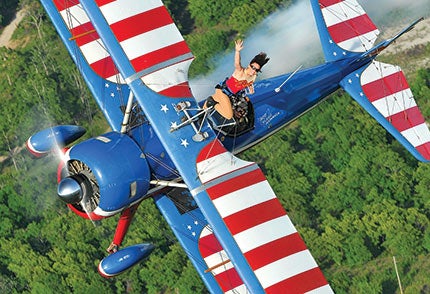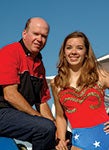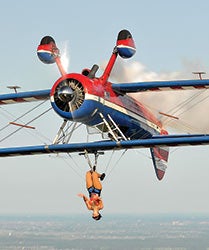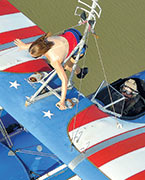Bugs & Hugs
The ’Glamorous’ Life Of A Wingwalker
 |
I've always been fascinated by people who voluntarily climb out of the seat of a perfectly safe airplane and onto its wing. My first experience seeing a wingwalking performance was at an air show in Florida, where a biplane in a power dive caught my attention. On top of the wing was a woman waving frantically at the crowd. Pilot Greg Shelton and wingwalker Ashley Battles were gaining speed for their first maneuver. Through my zoom lens, I was amazed at how composed Ashley was through loops, rolls, hammerheads and even snapping maneuvers, all the time grinning from ear to ear. Why would anyone ever think of doing this? "Is there Velcro on the bottom of her shoes?" I thought to myself.
"It's mostly about the young people for me," says Ashley. "All of the kids just love our show; they have so many questions. Some are humorous: 'Do you have Velcro on your shoes to stay on the wing?' [Oh well!] Most have intelligent inquiries, showing surprisingly keen interest in what it's really like on top of the wing." Ashley, in her Wonder Woman outfit, has these kids entranced, and she happily signs autographs and poses for pictures. "It's what I love most about this business," she explains.
 Greg Shelton and Ashley Battles have been performing their wingwalking routine together since 2003. |
You have to wonder what Ashley's mom thinks about this career choice; after all, she was only 20 when she first went out on the wing in 2003. "Actually, she's very supportive of me. She's the only one who hasn't said, 'you're crazy for doing this,'" muses Ashley. Raised in Georgia, Ashley originally moved to Oklahoma to pursue a degree in aviation management. After five years of flying straight and level, Ashley became interested in air shows and aerobatics. She was introduced to Greg Shelton, who was looking to add a wingwalking act to his Stearman routine. Greg asked Ashley if she had ever wingwalked before, and Ashley asked right back if he had ever flown with a wingwalker. The answers were both the same: "No!" What a perfect pair.
So, I had to ask, how does one go from no wingwalking experience to show-qualified? "Very carefully," says Ashley. "Imagine rock climbing in hurricane-force winds---in tights, having to smile and wave at an audience---and not looking terrified!" After witnessing Ashley climb to the top wing of the Stearman during the air-to-air shoot for this article, it's clear that it is a lot like rock climbing. Her initial training started on the ground, where she worked on getting her footing down cold, transitioning from the front cockpit to the top-wing rack and the javelin (a piece of wood the size of a broom handle that keeps the guy-wire vibration to a minimum), and back to the cockpit. Around her waist is a safety harness with a carabiner, and just like a rock climber, as she takes a step, she moves the carabiner to different parts of the plane's wing bracing for security.
 |
At some point, anyone who wingwalks must take that initial first step out of the seat belt. "Because it's so loud in the cockpit, and I can't wear a headset, we worked out a series of visual cues to communicate," explains Ashley. A wing waggle by Greg signals to Ashley that it's time to climb out or to come back in. If Ashley crouches low on the wing and/or gives a thumbs-down sign, Greg will stop the show, slow down and fly straight and level.
"So, it's the first time to climb out of the cockpit at our first air show, in Bartlesville, Oklahoma," recalls Ashley. "I remember worrying about how I would distinguish between turbulence and Greg's signal to get out on the wing. My answer came soon enough as my head nearly hit the side of the cockpit when Greg vigorously rocked the wings!"
 |
She started to climb up, one foot after another, being careful to follow her practiced route. The wind strength took her by surprise: "I reach for the top-wing rack, and my arm blows behind my head. At this moment, I realize all of my ground rehearsal has gone to the wind (literally); I hadn't anticipated the body positions I would need to combat the wind." She went on to describe how she had to swallow her fear and just focus on where to place each hand and foot. "It was so hard to breathe, and just when I wondered how I would be able to stand up, I pulled my last limb onto the top wing, out of the propwash, and I was pleasantly surprised that the turbulence wasn't that bad!" To help Ashley out with the transition, Greg made sure to have enough altitude to throttle way back so that the propwash was minimized and there was room for a shallow descent to maintain airspeed.
 Transitioning from the cockpit to the top of the wing is like rock climbing; as she takes a step, Ashley moves the carabiner for safety. |
During shows, Greg's speed ranges from 65 to 160 mph when Ashley is on the javelin; he maintains a max speed of 145 mph when she's on the top wing, as he dives for loops and hammerheads. He doesn't ever exceed 4 G's, but "I hadn't done very much in the way of aerobatics so my G-tolerances weren't there," Ashley recalls of their first show. "During the first loop, I grayed out and just kind of rode along with everything a blur."
Greg, who flies a fantastic solo act in the 450 hp Stearman, says the biggest effect of having Ashley on the wing is vertical penetration. When flying solo, he counts on around 1,000 feet but cuts that in half when Ashley is on the wing. Greg keeps the show above 200 feet, mainly "to keep her out of the bugs." Laughing, Ashley adds, "A big postflight check before I go sign autographs is to give Greg a big smile so he can look for any dead bugs remaining on my face and, yes, on my teeth. Glamorous, isn't it?"
With visions of Susan Sarandon falling off of the wing in The Great Waldo Pepper, most people wonder why anyone ever started wingwalking in the first place. Historians credit a WWI pilot cadet by the name of Omar Locklear as the very first wingwalker. A mechanic out of Fort Worth, Texas, Locklear started going out on the wing of his Curtiss Jenny while his instructor flew so he could work on problems with the plane. He became such a phenomenon that his superior officers asked him to perform demonstrations for other cadets, showcasing the stability of the Jenny. Wingwalking was born! After the Great War, Locklear and others, like Charles Lindbergh, barnstormed all over the country in a series of "one-upmanship" looking for new ways to thrill audiences. Disregarding any safety equipment, many died performing daredevil acts, from playing tennis on the top wing to hanging by the teeth from a trapeze supported on the undercarriage.
 |
Today, wingwalking is an entirely different animal. I was surprised to learn that the most dangerous part of it isn't falling off of the wing, as you might imagine, but getting hit by a bird! "The harness is designed to keep me on the wing even if I slip," says Ashley, "although there would be some pretty nasty bruises if that were to happen." So far, the biggest mishap has been losing her goggles during a routine. Still, one has to wonder if this is all worth it. "I love aviation and I love entertaining," says Ashley. "I love the hugs and high fives from little kids, and the fact that maybe I can inspire someone to follow their dreams, like I have." For more, visit www.gregsheltonairshows.com.

Subscribe to Our Newsletter
Get the latest Plane & Pilot Magazine stories delivered directly to your inbox






